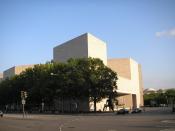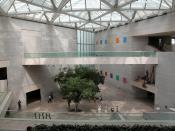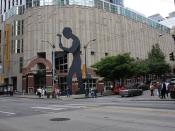National Gallery of Art in Washington in I. M. Pei's East Building is celebrating its 25th anniversary by taking down "Woman," the Miró tapestry that has always been displayed at this museum, and put up "Color Panels for a Large Wall," an artwork of 18 rectangular toneless canvases by Ellsworth Kelly. The problem here is the fact that this it the first time any other artists' work besides, Miro, will be on display. One must wonder how this will affect the museum and its viewers.
Location and display are a big part of the feeling viewers get from a museum, however, the art itself plays a major factor in the experience. The fact that this is all not only a certain genre, but the exact same artists offers the idea that this museum conveys a strong sense of purpose and stability in that it is there to educate viewers on Miro's artwork.
Once any other artist is added to the collection the change will bring about a change in meaning for the museum, and it is unknown to me.
On a more positive side, the panels have been dated back to the same year as the construction of the museum, giving it a sense of age to the viewers to appreciate. How the entire place is displayed plays an important role in the viewers' appreciation for the museum and the art inside it. The nice part here is the fact that this museum is constructed with square walls compared to the normal rectangular wall looks many buildings use. The original design of "Color Panels for a Large Wall" made up of two horizontal rows of nine panels, an arrangement that suited its previous homes long, narrow wall. But since the National Gallery's space is more of a square the...


